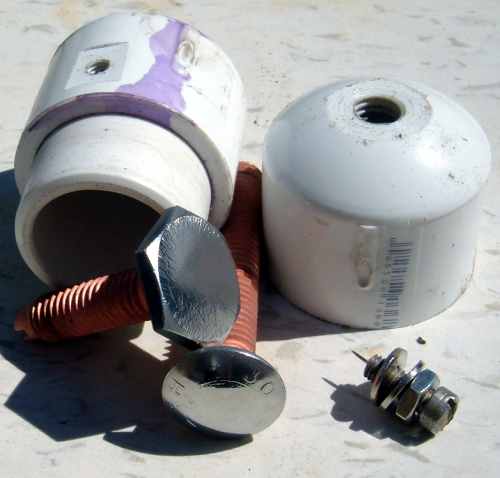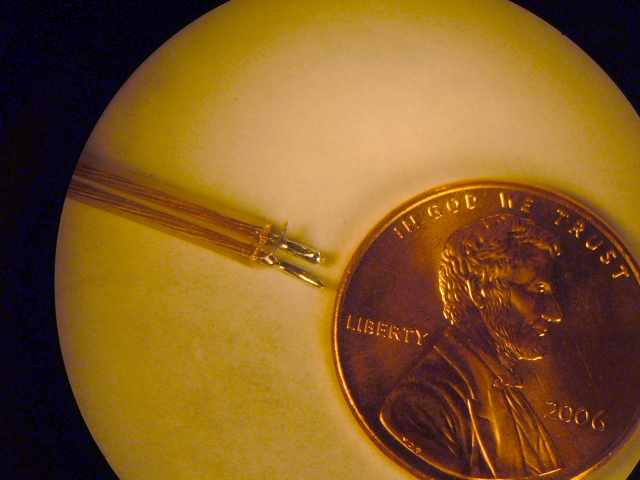 Nearly everyone knows what an assembled spark gap looks like, but just
in case, here it is ready to go. Pairs of nuts will adorn the ends and
clamp the wires between the main terminals, and the trigger will come
into the 10–32 screw on top. The trigger spark emits enough
ultra–violet light and probably a little ionized metal to start current
flowing through the main gap, which is set far enough apart to not trigger
without this stimulus. This might be very important for some of our
projects, as the little rail gun this will drive is used as a detonator
for explosives. The idea is to make something safer than mercury
fulminate or lead azide based detonators. Both of those are dangerous
AND poisonous, though we make those too. Our detonator design might
be called a "chip slapper". The idea is to have a short little
rail gun accellerate a small cloud of plasma to a high enough speed to
shock-initiate some HE, which in our case will be PETN. The plasma will
originate as a small piece of wire between the rails at the beginning of
the 1/4" long rails. I have tried 1 mil gold, tungsten, and other
things my sources say work, but frankly, a strand of the cheap speaker
wire that makes up the rails seems to work just as well. Probably because
I don't really need anywhere near this much energy to do the job. Well,
I have it, and reliability is a very good thing
around explosives! In this design, ensuring the capacitor isn't charged
is enough to guarantee no unintended firing, short of getting hit with
a bolt of lightning.
Nearly everyone knows what an assembled spark gap looks like, but just
in case, here it is ready to go. Pairs of nuts will adorn the ends and
clamp the wires between the main terminals, and the trigger will come
into the 10–32 screw on top. The trigger spark emits enough
ultra–violet light and probably a little ionized metal to start current
flowing through the main gap, which is set far enough apart to not trigger
without this stimulus. This might be very important for some of our
projects, as the little rail gun this will drive is used as a detonator
for explosives. The idea is to make something safer than mercury
fulminate or lead azide based detonators. Both of those are dangerous
AND poisonous, though we make those too. Our detonator design might
be called a "chip slapper". The idea is to have a short little
rail gun accellerate a small cloud of plasma to a high enough speed to
shock-initiate some HE, which in our case will be PETN. The plasma will
originate as a small piece of wire between the rails at the beginning of
the 1/4" long rails. I have tried 1 mil gold, tungsten, and other
things my sources say work, but frankly, a strand of the cheap speaker
wire that makes up the rails seems to work just as well. Probably because
I don't really need anywhere near this much energy to do the job. Well,
I have it, and reliability is a very good thing
around explosives! In this design, ensuring the capacitor isn't charged
is enough to guarantee no unintended firing, short of getting hit with
a bolt of lightning.
 Here is the gap taken apart. For reasons that should be obvious, the
pipe is only glued to one of the caps. One big reason for doing this
in PVC pipe, other than that it's a good insulator and alignment jig, is
that the prototype gap was VERY noisy, comparable to a .38 pistol
shot in the room. Even with warning, everyone jumped (and there were
more–embarrassing mishaps). Since the planned application will only
need the gap to fire infrequently, there is no need for ventilation and
cooling, as there would be for instance with a gap used for a Tesla coil.
The expected failure mode for this gap will be pitting and evaporation
of the main electrodes onto the plastic, rendering it conductive.
Here is the gap taken apart. For reasons that should be obvious, the
pipe is only glued to one of the caps. One big reason for doing this
in PVC pipe, other than that it's a good insulator and alignment jig, is
that the prototype gap was VERY noisy, comparable to a .38 pistol
shot in the room. Even with warning, everyone jumped (and there were
more–embarrassing mishaps). Since the planned application will only
need the gap to fire infrequently, there is no need for ventilation and
cooling, as there would be for instance with a gap used for a Tesla coil.
The expected failure mode for this gap will be pitting and evaporation
of the main electrodes onto the plastic, rendering it conductive.
 Here are the separate pieces. As contact evaporation was a big concern
based on work with a prototype, the gap faces here were plated, first
with copper, and then with chromium, quite thickly, not the decorative
stuff. First the zinc galvanizing was stripped off with hydrochloric acid,
then the copper and chrome plating were applied. The copper makes a
good base, and is very thermally and electrically conductive compared to
hardware store iron. Due to skin effect, the current in a high frequency
waveform flows mostly on the surface of the conductor, ignoring the bulk,
so the copper ought to make a difference. The chrome is there as it
is the hardest to evaporate metal we can electroplate.
Here are the separate pieces. As contact evaporation was a big concern
based on work with a prototype, the gap faces here were plated, first
with copper, and then with chromium, quite thickly, not the decorative
stuff. First the zinc galvanizing was stripped off with hydrochloric acid,
then the copper and chrome plating were applied. The copper makes a
good base, and is very thermally and electrically conductive compared to
hardware store iron. Due to skin effect, the current in a high frequency
waveform flows mostly on the surface of the conductor, ignoring the bulk,
so the copper ought to make a difference. The chrome is there as it
is the hardest to evaporate metal we can electroplate.The trigger electrode is a 10–32 screw with a sewing pin soldered into a hole drilled in the end. The sharp point will make it possible to trigger the gap with a relatively lower voltage. Sure is nice to have a machine shop, this was an easy part to make! As to the general machining, not that much was done. The caps had flats turned on the ends, were shortened, and tapped 3/8 x 16 to match the standard bolts. A flat was cut on one side to work with the washers for the trigger electrode. Not required, but nice. Once this is ready to go into real service, there will be a couple of holes drilled and tapped on the bottom, which will also get a flat, for mounting with nylon screws. If past experience means anything, this thing will try to come apart under the various forces involved. We only want that to happen when we desire it for maintenance.
 Here is an example of a miniature rail gun. This is just very cheap
speaker wire, stripped back about 1/4", tinned, and with one
conductor folded to short the beginning of the rails. In use, a blob
of PETN in nitrocellulose–based glue will cover the end of the
rails. This in turn can detonate a larger charge in a normal sized
blasting cap. You might be wondering how one can make 2500 Volts go
down this cheap wire. If you think about it, the voltage doesn't happen
until after all the action is over, and any residual charge in the capacitor
is wasted anyway. A huge current pulse is sent down
the wire, and the resulting magnetic field operates the rail gun, usually
vaporizing the projectile, which just does not matter to the
application, it still has the momentum and velocity to do the job, no
matter the form of matter. In previous tests, nearly the whole thing is
more or less
destroyed, and interesting holes appear in a witness plate placed downrange
a little from the end. This is a safety–glasses and hearing protector
sort of thing
when done indoors, but of course actual use will not be indoors, nor will
the user be very close by! In use, the main cable of course, is the
good stuff; the rail gun is only a couple of inches at the end of it.
We use 4 conductors of #10 for this. Regular romex works
fine too.
Here is an example of a miniature rail gun. This is just very cheap
speaker wire, stripped back about 1/4", tinned, and with one
conductor folded to short the beginning of the rails. In use, a blob
of PETN in nitrocellulose–based glue will cover the end of the
rails. This in turn can detonate a larger charge in a normal sized
blasting cap. You might be wondering how one can make 2500 Volts go
down this cheap wire. If you think about it, the voltage doesn't happen
until after all the action is over, and any residual charge in the capacitor
is wasted anyway. A huge current pulse is sent down
the wire, and the resulting magnetic field operates the rail gun, usually
vaporizing the projectile, which just does not matter to the
application, it still has the momentum and velocity to do the job, no
matter the form of matter. In previous tests, nearly the whole thing is
more or less
destroyed, and interesting holes appear in a witness plate placed downrange
a little from the end. This is a safety–glasses and hearing protector
sort of thing
when done indoors, but of course actual use will not be indoors, nor will
the user be very close by! In use, the main cable of course, is the
good stuff; the rail gun is only a couple of inches at the end of it.
We use 4 conductors of #10 for this. Regular romex works
fine too.The picture was taken through one eyepiece of our stereo microscope, at about 10x magnification. I am surely going to have to get a whiter light source for this, although it looks fine to the human eye as is. What I am using now is a pair of compact fluorescent lamps, which are warm white.